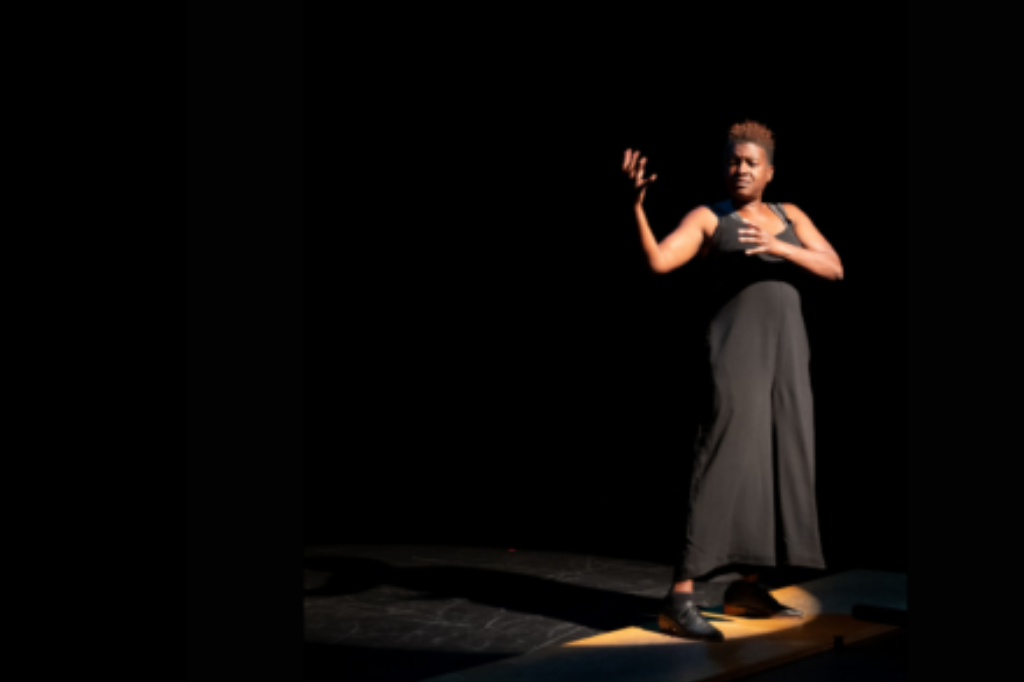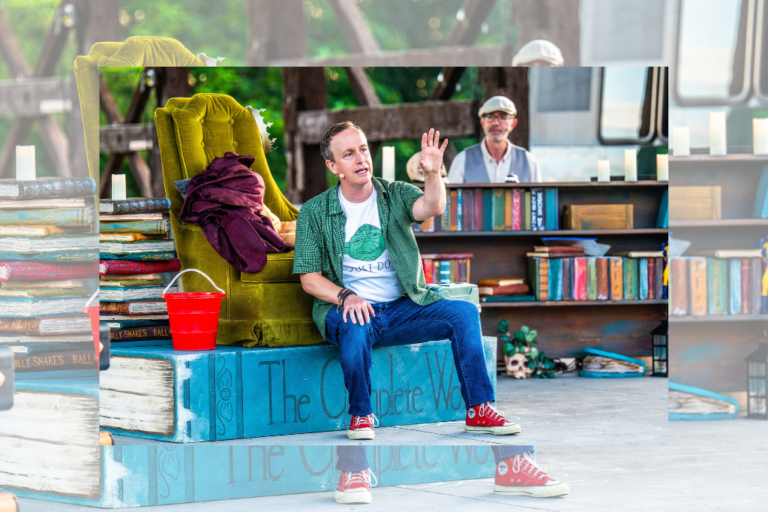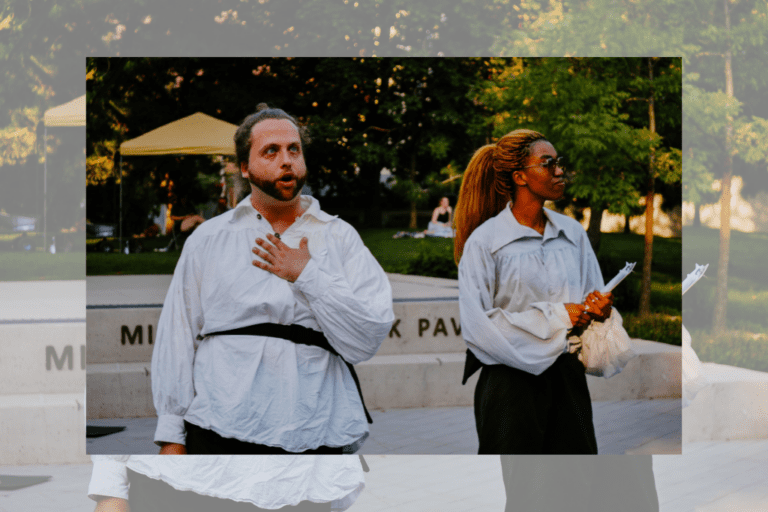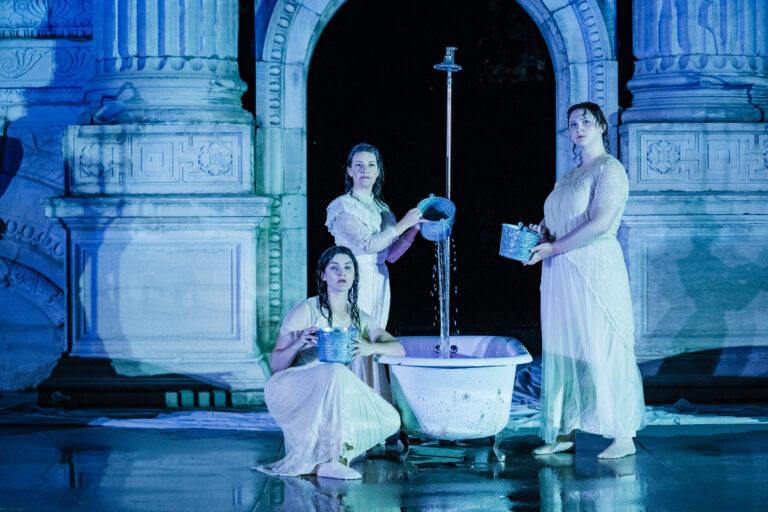Speaking Vibrations: In Conversation with Jo-Ann Bryan and Carmelle Cachero
Ottawa’s Great Canadian Theatre Company (GCTC) recently unveiled their 2022/23 season, but they’re not waiting until autumn to bring audiences unique shows and a sense of community. While Speaking Vibrations, the latest show to take the stage in the Irving Greenberg Theatre Centre, isn’t a show specifically about revolution, it is, at its core, a revolutionary product.
“I don’t think it’s anything anyone’s experienced before,” said co-creator and producer Carmelle Cachero in our mid-afternoon Zoom interview.
“There’s no way to prepare people for this experience, just because we’ve tried to incorporate as much as we could in the experience.”
If it seems as though the word experience is being repeated a lot, there’s good reason: it’s hard to find another way to describe Speaking Vibrations. The show combines a variety of technical and performance elements to create an abstract, multisensory storytelling experience that allows audiences to find their own meaning. Accessibility has been worked into every aspect of the production, including a motion-triggered vibrotactile installation by Jesse Stewart for patrons to enjoy in the lobby. In the performance, four performers take the stage, melding ASL poetry and song, music, rhythm tap, and dance with technical elements both on stage and in the audience. Feeling and vibration meet projection and sound to create a rich landscape for audiences to interpret and enjoy.
“It’s not about everyone experiencing the show in one way, but about having your own experience,” said Cachero. “No two people have the same experience leaving the show; it all depends on your own experiences and what you’re attuned to.”
While the show doesn’t tell a single, narrative story, the creators spent plenty of time connecting and discovering how their individual stories and experiences connected. It was in these journeys that they discovered how identity and language has impacted them as individuals. For Jo-Ann Bryan, another of the show’s co-creators and performers, her story is inspired by her upbringing, and told through motion and expression.
My parents are from Barbados, and so I’m a first generation that was born in Canada, she signed over Zoom.
I’m the only Deaf person in my family. The language of my family is English, which presented communications issues for me, and I ended up incorporating both languages. I had the opportunity to incorporate Black history and culture from my parents, and deaf language and Deaf culture from the Deaf community, so I have those two identities incorporated in myself. I really connect with some members of the audience, particularly members who are first generation Canadains whose parents are Black. I also really connect with the Deaf audience. When those two identities come together — Deaf and Black — that’s an experience I can speak to.
As Cachero and Bryan describe the show, I’m struck by the incredible amount of work that went into creating and presenting this production. The feelings and vibrations Cachero described are created using vibrotactile technology both onstage and in the audience.
“There were so many pieces to make it accessible… I reached out to David Bobier, the founder and director of VibraFusionLab — I had seen his technology used in other shows before — and he provided the belts and pillows that we used in the audience to allow folks to feel the sound,” she explained.
“We had the risers built so that it was comfortable to tap dance on but also reverberated so we could feel the vibrations when we were on the stage stamping and doing the dance. The floor was miked to trigger the vibrotactile technology; I had these special tap mics that were made for tap dancers on each foot, also triggering the vibrotactile technology.”
Belts, vests, pillows, seats, a bass-shaker set to bpm: all of these elements were used to give audiences a tactile experience throughout the show. It’s a massive undertaking, but according to Bryan, the success of Speaking Vibrations is largely due to its meticulous planning from the start.
GCTC’s willingness to work with us — not just with the last minute addition of an interpreter, but from scratch, incorporating the design, the lighting, the space — was amazing. They made the effort to be holistically accessible not only to a Deaf audience, but to a non-Deaf audience as well.
Bryan believes that the concept of accessibility needs to be reframed, both within the Deaf community and outside it.
Often, non-Deaf people think, “oh, this is accessible for Deaf people or people who use wheelchairs,” but accessibility applies to all, she signed. If you go to a theatre, your aim is to take in, and enjoy what you’re watching. It needs to be accessible for all of that. It needs to be a consideration.
The deaf community is incredibly diverse: sometimes Deaf-Blind are left out of the equation, or we’ll forget Deaf-plus people, such as deaf people who are on the spectrum and have autism. These are considerations we need to have, both within the deaf community, but also broader.
This isn’t the first time Bryan and Cachero have incorporated vibrotactile technology into their work. Alongside Jordan Samonas, Speaking Vibrations’ co-creator and producer, and King Kimbit, a hip-hop poet, educator, and community activist, they first crafted an accessible concert as part of the 2019 Uproar Festival in Ottawa. Vibrotactile devices and balloons provided audiences with a multisensory experience, but according to Cachero, the experience didn’t end there.
“The technology was part of our old show from the beginning,” she said, smiling. “It just expanded into the fact that we now have 75 devices in the audience that are all triggered by vibrotactile vibrations. It grew from 10 to 75; in this version, we also have the vibrotactile floors to create new experiences for wheelchair users and those with mobility aids.”
It was after Uproar that they were approached by director Jacqui du Toit, who joined the group for what would have been a 2020 staging at Origin, an arts and community centre co-owned by du Toit.
Unfortunately, the pandemic dashed hopes for a 2020 production, in which the team had planned to build upon the successes of their Uproar production. The team pivoted to an online production, which was shot at GCTC in 2021, but not all of the elements of the show translated smoothly.
“Of course, a huge part of what we do is the vibrotactile component, so we did do an online version but it wasn’t the whole vision we had for the show,” Cachero said. “So, Jordan and I applied for the Digital Now grant through the Canada Council. It’s how we were able to put into production what we had envisioned.”
Now, with the means and opportunity to bring their dream to life onstage, Speaking Vibrations has incorporated new technologies and ideas to make the experience accessible to even more communities.
The visual elements that we incorporated were abstract, Bryan explained. We didn’t stick to ASL as a language, but tried to incorporate visual elements that were understood by all.
“Leslie Marshall, who is a projection designer, created our projections with creative captions that were incorporated into the visual design of our backdrop,” Cachero added. “So there’s motion in the images that she created but also with the aesthetic of access with the words either being signed, spoken, or sung included in the projection.”
There are always challenges when presenting a dramatic piece that includes ASL performance, and in this case, it was ensuring that the show was lit so that all of Bryan’s expressions and movements could be clearly seen as she signed. It was one of the many reasons the team brought in a second director to help out with the cultural aspects of the show.
It’s challenging to explain the Deaf perspective of a show, so when Pamela Witcher, our Deaf culture director got involved, it was to share the perspective with deaf eyes and a cultural lens as well, Bryan noted.
I’m not able to see myself onstage, I’m not able to have the audience’s perspective, she continued. So with Pamela sitting there as an audience member, she could provide us with crucial feedback on the visual elements of the show, like my use of sign language, visual vernacular, the use of my body and my facial expression, and if the lighting was affecting the visual parts of the performance.
Throughout the process of creating this show, the Speaking Vibrations team has grown in exciting ways. Just as Witcher came onboard to provide a new and necessary perspective, stage manager Kat Wong joined the team to give Cachero and Samonas space and to focus on their performances.
“We’ve grown from before. Kat Wong was essential in helping us get all of this… They stepped in as a stage manager, and we are so grateful to have someone that open-minded because it’s not just regular stage managing with this because of all of the aspects. Having them here and supporting us has been invaluable.”
According to GCTC’s interim artistic director Sarah Kitz, the show fit perfectly into the company’s 2021/22 season.
“Speaking Vibrations was crafted by four local artists, and the 2021/22 Season was focused on uplifting artists in Ottawa,” she said in an email. “It is my intention to do more of this in the future. There’s a big project in the works which is specifically aimed at bringing local work to the GCTC stage.”
She added that GCTC has further plans to expand their accessibility policies and procedures to create a theatre that is even more welcoming to all.
“[Theatre is] for the people,” she said. “I hope in the future we will be able to add even more access initiatives. I think accessible theatre and disability theatre are showing us the future. Inclusivity breeding innovation. New ways of thinking about performance, who it is for and what it can do. I hope that the production of Speaking Vibrations is a site of inspiration for mainstream theatres to consider how they can create more accessible work from the ground up, and the central place that disability theatre can occupy. Bring the margins to the centre.”
It’s almost odd to think about how revolutionary this simple statement is. In a world where theatre performance is often treated as a strictly regulated form of high art, finding a show that has deliberately been created to provide accessibility for everyone truly seems revolutionary. The 75-minute show had a 20-minute intermission, but patrons never found themselves restricted by that run time. As Cachero noted, Speaking Vibrations went beyond the scope of the usual assistive devices and assigned seating for Deaf and disabled patrons.
“We’ve kind of approached this as a relaxed show: we’re open to people treating every performance as a relaxed performance. If they need to move around, do something, stop the vibrotactile, go to the washroom, that’s great! We really want everyone to feel comfortable in the space.”
These seemingly small choices can have a massive impact on the individuals they affect.
“The Deaf community is used to Jo-Ann and I interpreting theatre, so they’re reaching out to ask what day they should come, and I’m telling them, ‘any day.’ Usually it’s like, ‘email me and I’ll set aside the deaf seats,’ but now it’s any day. You can just buy the tickets normally at the box office and attend the show. This show, you sit anywhere you want!”
Though the Speaking Vibrations team is already full of ideas for their next prospective show, their visions extend beyond their own company, even beyond Ottawa. Although incorporating technology and accessibility features into a production can seem like a daunting task, for Bryan, it’s doable if companies are willing to commit to the process.
Do it from the beginning of planning. Envision what you want to do and it will happen.
She noted that it’s important for companies to not just bring someone on because they’re Deaf: instead, theatres should look to build partnerships with artists because of their art, and because they want to express what that group wants to express.
I am deaf, but I want to be seen as an artistic peer to Carmelle and the rest of the team of Speaking Vibrations, I want to work in partnership. And it is possible, because we’ve manifested it here.
Through creativity, we can make a show accessible for all to enjoy.
Although the show closed in Ottawa on Saturday, June 4, it’s not too late to take in the performance. Speaking Vibrations is available to watch online until June 14 at noon.















Comments